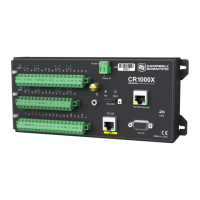help. Problem wires can also be tied directly to the ground lug to minimize induced single-ended
offset voltages.
Ground potential differences
Because a single-ended measurement is referenced to datalogger ground, any difference in
ground potential between the sensor and the datalogger will result in a measurement error.
Differential measurements MUST be used when the input ground is known to be at a different
ground potential from datalogger ground.
Ground potential differences are a common problem when measuring full-bridge sensors (strain
gauges, pressure transducers, etc), and when measuring thermocouples in soil.
l Soil Temperature Thermocouple: If the measuring junction of a thermocouple is not
insulated when in soil or water, and the potential of earth ground is, for example, 1 mV
greater at the sensor than at the point where the datalogger is grounded, the measured
voltage will be 1 mV greater than the thermocouple output. With a Type T (copper-
constantan) thermocouple, 1 mV equates to approximately 25 °C measurement error.
l
External Signal Conditioner: External instruments with integrated signal conditioners, such
as an infrared gas analyzer (IRGA), are frequently used to make measurements and send
analogue information to the datalogger. These instruments are often powered by the
same Vac-line source as the datalogger. Despite being tied to the same ground,
differences in current drain and wire resistance result in different ground potentials at the
two instruments. For this reason, a differential measurement should be made on the
analogue output from the external signal conditioner.
For additional information, see Minimizing offset voltages (p. 57).
6.1.3.3 Detecting open inputs
A useful option available to single-ended and differential measurements is the detection of open
inputs due to a broken or disconnected sensor wire. This prevents otherwise undetectable
measurement errors. Range codes appended with C enable open-input detection. For detailed
information, see the CRBasic help (VoltSE() and VoltDiff() instructions, Range
parameter)
The C option may not detect an open circuit in the following situations:
l When the input is not a truly open circuit, such as might occur on a wet cut cable end, the
open circuit may not be detected because the input capacitor discharges to a normal
voltage through external leakage to ground within the settling time of the measurement.
This problem is worse when a long settling time is selected, as more time is given for the
input capacitors to discharge to a "normal" level.
6. Measurements 50

